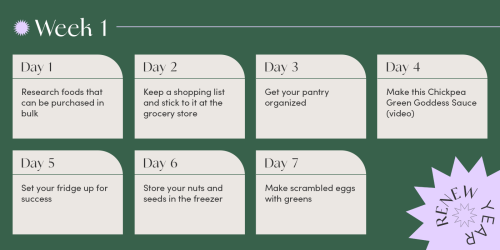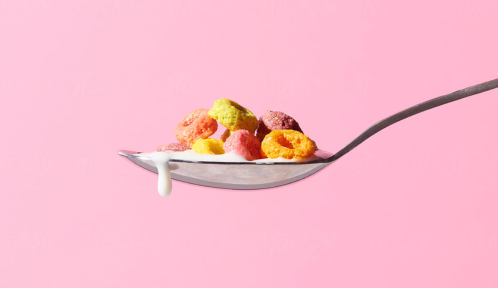Living a more sustainable, climate-conscious life is something that many people know is important. But actually making it a day-to-day reality can feel overwhelming—especially when it comes to eating.
I totally get it.
Between grocery shopping, figuring out what to make, and actually finding the time to cook it, mealtime can already feel like an anxiety-inducing ordeal. I promise you, however, that you can plan meals that don’t negatively impact the environment and don’t add any extra work to your plate. Like learning anything new, the key is to have the right tips and tricks on hand—and that’s where I come in.
Over the course of the month, I’ll show you some go-to ways to cook and eat sustainably that I’ve picked up while overseeing my busy restaurant, Dash & Chutney, a vegan Indian Street Food restaurant in Atlanta, Georgia. First, we’ll organize your kitchen and hone in on some food-shopping tips that minimize waste. Then, you’ll become a whiz at keeping foods fresh for longer and utilizing scraps to make food taste better. We’ll wrap up with a challenge to eat meat-free for one week, with guidance from me along the way. All the while, there will be recipes, hacks, and lightbulb moments that help you organically integrate waste-reducing practices into your lifestyle.
Consider this plan your guidebook on how to do it all. Every day in the month of January, beginning on January 3, I’ll share one fuss-free way to eat more sustainably. Here are the first seven, focused on getting organized. Ready to get started? Let’s jump in.

Day 1: Research foods that can be purchased in bulk
On Monday of each week, we’ll have a homework task that will prepare you for heading to the grocery store the following day. Today’s task? Research ingredients that you can purchase in bulk so that when you head to the grocery store tomorrow, you’re ready to start shopping in one of the most sustainable ways there is. You can do this homework by going to your grocery store’s online shop—many of which have been put into place following the pandemic—to see what’s available.
You might be wondering why buying in bulk is more sustainable, and here’s the answer: Not only can you bring your own reusable jars and bags to place your ingredients into, but you can also shop for both small and large quantities of food. For example, rather than getting a whole jar of bay leaves if you only need two or three, you can buy what you need; contrarily, if there’s a type of food you eat all the time, like beans or rice, you can buy as much as you’ll need for the long haul. Just be mindful of the expiration date on perishables, because you don’t want your bulk items to go bad before you can eat them up.
Day 2: Keep a shopping list and stick to it at the grocery store
One very simple way to cut down on food waste is to head into the grocery store with a plan. Just like your daily to-do list, having a plan keeps you focused on what you actually need. Before doing your grocery shopping, sit down and figure out what you actually want to eat this week, what you have in your refrigerator already, and what ingredients you need. This will prevent you from ending up with produce items that you bought with good intentions, but that don’t actually fit into any of your meals, as well as help you cut down on buying duplicates of items you already have. (If you have three half-used jars of salsa in the fridge, you know what I mean.)
This week, we’ll be making a Chickpea Green Goddess Sauce and Scrambled Eggs With Greens, which use the sauce. Here are the ingredients that you’ll need:
- ½ can chickpeas, drained and washed
- 1 cup cilantro, loosely packed
- 1 cup parsley, loosely packed
- 1 small clove garlic
- ½ small serrano pepper
- ½ lemon, juiced
- Kosher salt to taste
- ½ teaspoon cumin powder
- ½ teaspoon coriander powder
- ½ teaspoon cumin seeds (optional)
- 3 organic eggs or plant-based egg substitute
- 1 cup baby spinach, washed
- 1 tablespoon olive oil or avocado oil
Day 3: Get your pantry organized
Lots of food waste happens as a result of forgetting what you already have on hand, which is why it’s important to get your ingredients organized. Today, we’re tackling the pantry. Since pantry items can last a long time, it’s particularly easy to forget about what’s buried in the back of shelves.
Create a pantry hierarchy, which is a way of organizing your dry goods so that the items you use most frequently are in front and are the easiest to access. For example, if you cook consistently but only bake a couple of times a year, stash flours, sugars, and baking spices on your highest pantry shelf so your dinnertime staples can be a little lower—front and center.
As for those items you tend to forget about, store them alongside items that you typically combine them with in recipes. For example, there are four or five spices I use almost every time I make Italian-inspired dishes, so I keep all those spices together. If I realize there is another spice that would work well with them that I forget about, I’ll add it to the group. That way, the next time I’m making lasagna or ravioli, I’ll remember to use it. This is an easy (and inspiring!) way to experiment with flavor, too.
One of the most common mistakes I see people make with food storage is keeping their cooking oils right next to the stove. I totally get it: You use them all the time, so you want them within reach. But this is destroying your precious liquid gold! Heat and light both break down oils, which makes them go rancid quicker. Instead, store them somewhere that isn’t exposed regularly to light, like the pantry.
Likewise, many people keep their spice rack right next to the stove, too. Similar to oils, the best place to store them is away from light and heat. You’ll know if a spice has gone rancid because it will lose its vibrant color and won’t taste as flavorful.
Day 4: Make this Chickpea Green Goddess Sauce
You know how you have that one cooking oil that’s your go-to for pretty much everything? My homemade chickpea green goddess sauce works similarly, giving great flavor to anything I top it with. Get this: Literally, every ingredient in it is full of nutritional benefits, too. You can store the sauce in a glass container in the refrigerator for up to two weeks.
Day 5: Set your fridge up for success
Earlier this week, we tackled the pantry, now it’s on to the fridge. Just like with your pantry, it’s easy to forget about what’s in your fridge. If something is out of sight, it’s often out of mind. For this reason, I like to put foods I want to be extra mindful to use (like produce that only has about a day of life left) front and center.
Avoid hiding produce in the crisper if you’re going to forget about it there: Put it smack dab on that top or middle shelf. In the restaurant world, this waste-reduction strategy is referred to as ‘first in, first out.’ For instance, leftovers from lunch shouldn’t be consumed before you’ve finished what you cooked two nights ago.
On that note, there’s more food safety involved when it comes to the fridge than in the pantry, so that’s something else to consider. If you buy meat, keep it on the bottom shelf; you don’t want bacteria dripping onto your produce. Also, don’t leave anything uncovered in the fridge (like a plate of leftovers) because bacteria can form on it. Both of these rules are mandatory in commercial kitchens and are great to follow at home, too.
Day 6: Store your nuts and seeds in the freezer
Now that your ingredients are organized, I’m sharing a few smart ways to help them last longer. First up: nuts and seeds. A lot of people are surprised when they open my freezer and find that it’s where I store all my nuts, but this is actually a great way to make them last longer. Exposure to light and heat makes nuts go rancid quicker; the fattier the nut, the quicker this happens too. A sure sign that your nuts or seeds have gone rancid is that they taste bitter. Keep them in the freezer and you’ll extend their shelf life from three months to between six months and a year—a huge difference!
Day 7: Make scrambled eggs with greens
Check out the full recipe here.
Today, we’ll be making scrambled eggs with greens, utilizing the chickpea green goddess sauce that we prepped earlier in the week. I love this dish because it’s the perfect “refrigerator cleanout” meal—you can toss in whatever odds and ends of produce you have in the fridge that you don’t want to be wasted (and eat it for breakfast, lunch, or dinner). I call for spinach but feel free to also use that half an onion, handful of parsley, and slice of cheddar you might have on hand.
Looking to hit refresh on your healthy habits this January? Check out our full 2022 ReNew Year program for expert-led plans for better sleep, nutrition, exercise, and self-care routines.
Sign Up for Our Daily Newsletter
Get all the latest in wellness, trends, food, fitness, beauty, and more delivered right to your inbox.
Got it, you've been added to our email list.










